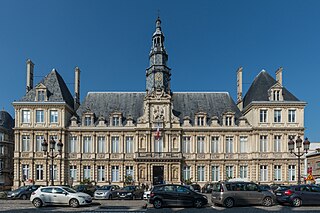Eustache le Peintre de Reims or Eustache de Rains (fl. 1225–40) was a trouvère from Reims, possibly a painter (peintre), but that may just be a family name. Seven poems of his are preserved in surviving chansonniers.
Floruit, abbreviated fl., Latin for "he/she flourished", denotes a date or period during which a person was known to have been alive or active. In English, the word may also be used as a noun indicating the time when someone flourished.
Trouvère, sometimes spelled trouveur[tʁuvœʁ], is the Northern French form of the langue d'oc (Occitan) word trobador. It refers to poet-composers who were roughly contemporary with and influenced by the troubadours but who composed their works in the northern dialects of France. The first known trouvère was Chrétien de Troyes and the trouvères continued to flourish until about 1300. Some 2130 trouvère poems have survived; of these, at least two-thirds have melodies.

Reims, a city in the Grand Est region of France, lies 129 km (80 mi) east-northeast of Paris. The 2013 census recorded 182,592 inhabitants in the city of Reims proper, and 317,611 inhabitants in the metropolitan area. Its primary river, the Vesle, is a tributary of the Aisne.
Eustache addressed one of his songs, Amours, coment porroie chancon faire, to Guigues IV, Count of Forez and Nevers. Guigues participated in the Barons' Crusade of Theobald I of Navarre in 1239 and died in 1241; Eustache's poem was probably written during this time.

Guigues IV or Guy IV was the count of Forez, Auxerre and Tonnerre from 1203 and the count of Nevers from 1226. He was still a child when his father, Guigues III, died on the Fourth Crusade and he inherited Forez. His mother was Alix and his uncle, Renaud, archbishop of Lyon, acted as regent until he came of age in 1218.

The Barons' Crusade, also called the Crusade of 1239, was in territorial terms the most successful crusade since the First. Called by Pope Gregory IX, the Barons' Crusade broadly spanned from 1234-1241 and embodied the highest point of papal endeavor "to make crusading a universal Christian undertaking." Gregory called for a crusade in France, England, and Hungary with different degrees of success. Although the crusaders did not achieve any glorious military victories, they used diplomacy to successfully play the two warring factions of the Muslim Ayyubid dynasty against one another for even more concessions than Frederick II gained during the more well-known Sixth Crusade. For a few years, the Barons' Crusade returned the Kingdom of Jerusalem to its largest size since 1187.

Theobald I, also called the Troubadour and the Posthumous, was Count of Champagne from birth and King of Navarre from 1234. He initiated the Barons' Crusade, was famous as a trouvère, and was the first Frenchman to rule Navarre.
All of Eustache's poems are in isometric decasyllables; stanzas are usually eight lines in length with two rhymes. His melodies are simple, and recorded in bar form. He must have participated in puys , for his Force d'Amours me destraint et mestroie is labelled a chanson couronnée (crowned, i.e. prized, song) in one of the manuscripts.
Decasyllable is a poetic meter of ten syllables used in poetic traditions of syllabic verse. In languages with a stress accent, it is the equivalent of pentameter with iambs or trochees.
In poetry, a stanza is a grouped set of lines within a poem, usually set off from other stanzas by a blank line or indentation. Stanzas can have regular rhyme and metrical schemes, though stanzas are not strictly required to have either. Even though the term "stanza" is taken from Italian, in the Italian language the word "strofa" is more commonly used. There are many unique forms of stanzas. Some stanzaic forms are simple, such as four-line quatrains. Other forms are more complex, such as the Spenserian stanza. Fixed verse poems, such as sestinas, can be defined by the number and form of their stanzas. The term stanza is similar to strophe, though strophe sometimes refers to irregular set of lines, as opposed to regular, rhymed stanzas.
A rhyme is a repetition of similar sounds in the final stressed syllables of two or more words. Most often, this kind of "perfect" rhyming is consciously used for effect in the final positions of lines of poems and songs. Less strictly speaking, a rhyme may also variously refer to other types of similar sounds near the ends of two or more words. Furthermore, the word rhyme has come to be sometimes used as a shorthand term for any brief poem, such as a rhyming couplet or nursery rhyme.



